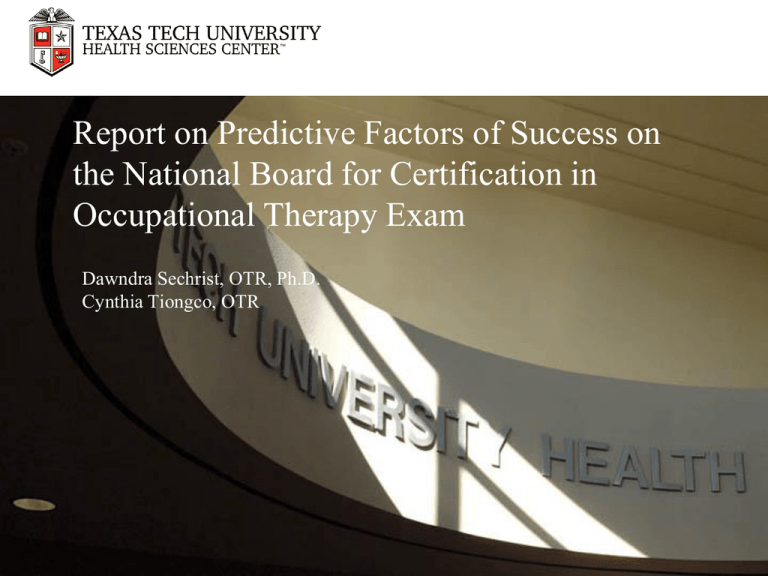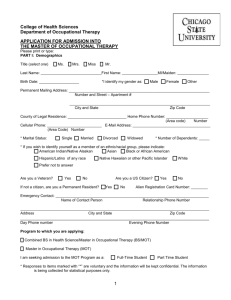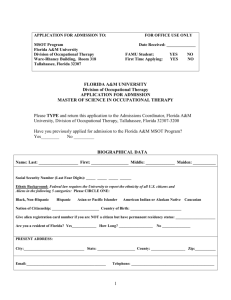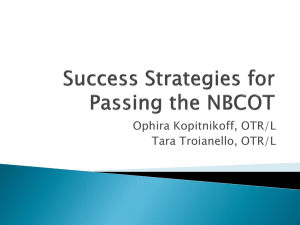2012-214F - Texas Occupational Therapy Association
advertisement

Report on Predictive Factors of Success on the National Board for Certification in Occupational Therapy Exam Dawndra Sechrist, OTR, Ph.D. Cynthia Tiongco, OTR Acknowledgements Special thanks to: • Sandra Whisner, OTR, MA Student researchers: • Samantha Breidenbach, MOTS • Hannah Curtis, MOTS • Brandi Featherston, MOTS • Cassidy Hunsaker, MOTS • Kate Karper, MOTS • Alex Lawton, MOTS • Courtney McGuire, MOTS • Jan Milstead, MOTS • Gretchen Saathoff, MOTS • Ben Wright, MOTS Learner Objectives • Identify factors significant and predictive to first time pass rate on the NBCOT exam • Discuss additional factors that could be explored for future research Purpose of the Study To determine the key factors to successfully pass the NBCOT certification exam on the first attempt. To guide Master’s of Occupational Therapy programs to select appropriate candidates for their program. To identify risk factors for students who do not pass the NBCOT exam on the first attempt. Literature Review ACOTE Standard (#A.5.4) “The average total pass rate of OT Master’s program graduates taking the national certification exam for the first time over the three most recent calendar years must be 70% or higher” (Accreditation Council of Occupational Therapy Education [ACOTE], 2006, p. 5). NBCOT Requirements Graduate from ACOTE program Complete fieldwork Agree to abide by NBCOT Candidate/Certificant Code of Conduct • (NBCOT, n.d., Eligibility Requirements). Literature Review • Overall grade point average (GPA) at admission. • Final cumulative GPA at time of graduation from program. • NBCOT review workshop • Interviews and essays Predictor Variables Overall grade point average (GPA) at admission into the Master of Occupational Therapy (MOT) Program Science GPA at admission into the MOT Program Completion of a Baccalaureate Degree at time of admission into the MOT Program Number of volunteer/observation hours at time of admission into the MOT Program Score on admission interview (percentage) Final score in Gross Anatomy (part of MOT curriculum) Introvert or Extrovert type on Myers-Briggs Type Indicator Sensing or Intuition type on Myers-Briggs Type Indicator Predictor Variables Score on 100-Question NBCOT practice pre-test (administered by MOT Program the first semester of the occupational therapy curriculum) Score on Occupational Therapy Knowledge Exam (OTKE) NBCOT practice pre-test (administered by MOT Program the first semester of the occupational therapy curriculum) Score on 100-Question NBCOT practice post-test (administered by MOT Program the sixth semester [last semester of didactic portion of the curriculum]) Score on OTKE NBCOT practice post-test (administered by MOT Program the sixth semester [last semester of didactic portion of the curriculum]) Student placed on academic probation during MOT program Final cumulative GPA at time of graduation from the MOT Program NBCOT review workshop attendance Methodology Recruitment of Subjects Retrospective review of student academic information and does not require recruitment of any subjects. Consent Procedures No consent procedures due to the nature of this study. Methodology Subjects Subjects consisted of graduates from an entry-level Masters of Occupational Therapy program over a five-year period to include approximately 156 graduate records. Inclusion Criteria • Enrolled and graduated from TTUHSC • Took the NBCOT exam within 12 months of graduation Exclusion Criteria • Inaccessible or unreported information Methodology Data Collection Procedures The MOT Program Director collected the information from the student files located in the MOT program and TTUHSC Office of Admissions. All data was de-identified by using RANDOM.org to randomly assign a number and compiled into an Excel file. Information was stored on a password protected spreadsheet on the Principal Investigator’s computer. The master list was destroyed once all data was obtained. Methodology Design for Analyzing Data Predictive modeling applying logistic regression was conducted to determine the relationship of all the variables on the outcome variable. Statistical Package for the Social Sciences (SPSS) was used to run the data analysis. Methodology Design Limitations Limited sample size Sample of convenience Possible missing factors Researchers lack of experience with logistic regression Methodology Potential Risks Family Educational Rights and Privacy Act (FERPA) was considered by the investigators and student information was adequately protected and destroyed once master list was made. Results Data Analysis Researchers obtained data from 97 records over a three year period (20082010) Of the 97 records, 92 were complete and were included in the final analysis Of the 92 records, 75 passed the NBCOT exam on the first attempt and 18 did not Results Descriptive statistics were run on the following 12 variables: Overall grade point average (GPA) at admission into the Master of Occupational Therapy (MOT) Program Science GPA at admission Bachelor’s degree at admission Interview score Myers-Briggs Type (sensing vs. intuitive) Gross Anatomy Grade Score on 100-Question NBCOT practice post-test Graduation GPA NBCOT review workshop attendance Fieldwork II:2 score Number of observation hours at admission Range of observation hours at admission Results Results After initial analysis, 4 factors were identified as possible predictors Overall GPA at admission Myers-Briggs type indicator (sensing vs. intuitive) NBCOT 100 question practice post-test MOT Program Graduate GPA A binary logistic regression was run using these variables with passing the NBCOT exam on the first attempt as the outcome variable. Results Predictors Score df p Overall GPA at admission 6.35 1 .012 Myers Briggs Type (S or N) 2.288 1 .130 100 question post-test 13.378 1 .000 Graduate GPA 10.130 1 .001 Overall 18.473 4 .001 Score = Roa’s efficient score statistic; df = degrees of freedom; p=probability value Results Included B(SE) Odds Ratio Constant -13.613(4.54) .000 Posttest .037*(.011) 1.037 Lower CI Upper CI 1.015 1.061 B = beta values; SE = standard error; CI = confidence interval; *p<.05 Discussion A higher score on the NBCOT 100-question posttest was predictive of students passing the NBCOT test on the first attempt. This was the only variable shown to be a predictor at this time. More research is needed to increase strength of these findings. Discussion Pilot study • Need to follow-up this study with more analysis Program Implications • Programs will be able to identify students that are at risk • Programs and students will have a better understanding of what is necessary for them to increase the likelihood of passing the NBCOT exam on the first attempt Future Research • Continuing over the years with TTUHSC MOT Students • Other programs References Accreditation Council for Occupational Therapy Education of American Occupational Therapy Association, Inc. (2006). Accreditation Standards for a Master’s-Degree-level Educational Program for the Occupational Therapist. Retrieved March 2, 2011, from http://www.aota.org/Educate/Accredit/StandardsReview.aspx Avi-Itzhak, T., & Krauss, A. (2010). A Formative Outcome Assessment for Evaluating Occupational Therapy Students' Proficiency and Skills for Passing the NBCOT Computer-Based Certification Test. Journal of Allied Health, 39, 81-87. Dawson, B. & Guy, R. (1994). Personality type and grade performance in a TV-assisted course. Journal of Personality Assessment, 41, 461-473. DeYoung, S., & Foti, L. (1991). Predicting success on the National Council Licensure Examination-Registered Nurse: another piece of the puzzle. Journal of Professional Nursing, 7, 99-104. Eligibility Requirements. (n.d.). Occupational Therapy | Certifications | NBCOT. Retrieved January 31, 2011, from http://www.nbcot.org Harrelson, G. L., Gallaspy, J. B., Knight, H. V., & Leaver-Dunn, D. (1997). Predictors of Success on the NATABOC Certification Examination. Journal of Athletic Training, 32(4), 323-327. References Hill-Besinque, K., Wong, W.Y., Louie, S.G., & Rho, J.P. (2000). Predictors of success rate in the California State Board of Pharmacy Licensure Examination. American Journal of Pharmaceutical Education, 64, 50 – 53. Hollman, J. H., Rindflesch, A., Youdas, J., Krause, D., Hellyer, N., & Kinlaw, D. (2008). Retrospective analysis of the behavioral interview and other preadmission variables to predict licensure examination outcomes in physical therapy. Journal of Allied Health, 37(2), 97-104. Kirchner, G. L., Stone, R. G., & Holm, M. B. (2000). Use of admission criteria to predict performance of students in an entry-level master's program on fieldwork placements and in academic courses. Occupational Therapy in Health Care, 13(1), 1-10. Landry, L. G., Davis, H., Alameida, M. D., Prive, A., & Renwanz-Boyle, A. (2010). Predictors of NCLEX-RN success across 3 prelicensure program types. Nurse Educator, 35(6), 259-263. Lysaght, R., Donnelly, C., & Villeneuve, M. (2009). Factors predicting applicant outcomes in occupational therapy education. Canadian Journal of Occupational Therapy Abstracts, 76(1), 38-47. Middlemas, D.A., Manning, J.M., Gazzillo, L.M., & Young, J. (2001). Predicting performance on the National Athletic Trainers’ Association Board of Certification examination from grade point average and number of clinical hours. Journal of Athletic Training, 36, (2): 136-140. References Myers, I. & McCaulley, M. (1996). MBTI uses in medicine and other health professions. Gainesville, FL: Center for Applications of Psychological Type, Inc. Myers, I. B., McCaulley, M. H., Quenk, N. L., & Hammer, A. L. (Eds.). (1998) MBTI manual: A guide to development and use of the Myers-Briggs Type Indicator (3rd Ed.). Palo Alto, CA: Consulting Psychologists Press, Inc. the Provost, J. (1992). Strategies for success: Using type to excel in high school and college. Gainesville, FL: Center for Applications of Psychological Type, Inc Reed, K.L. & Sanderson, S.N. (1999). Concepts of Occupational Therapy (4th ed.). Baltimore, MD: Lippincott Williams & Wilkins. Riddle, D., Utzman, R., Jewell, D., Pearson, S., & Kong, X. (2009). Academic difficulty and program-level variables predict performance on the National Physical Therapy Examination for licensure: A populationbased cohort study. Physical Therapy, 89(11), 1182-1191. Wong, S.K., Ramirez, J.R., & Helf, S.C. (2009). Student performance on levels 1 and 2-CE of COMLEX-USA: do elective upper-level undergraduate science courses matter? Journal of the American Osteopathic Association, 109, (11): 592-8.





